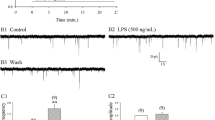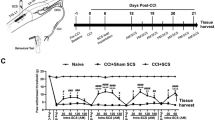Abstract
It is well known that remifentanil, a widely used intravenous anesthesia drug, can paradoxically induce hyperalgesia. The underlying mechanisms are still not clear despite the wide investigations. The present study demonstrated that withdrawal from spinal application of remifentanil could dose-dependently induce long term potentiation (LTP) of C-fiber evoked field potentials. Remifentanil withdrawal could activate Src family kinases (SFKs) in microglia, and upregulate the expression of tumor necrosis factor alpha (TNFα) in spinal dorsal horn. Furthermore, pretreatment with either microglia inhibitor Minocycline, SFKs inhibitor PP2 or TNF αneutralization antibody could block remifentanil withdrawal induced spinal LTP, whereas supplement of recombinant rat TNFα to the spinal cord could reverse the inhibitory effect of Minocycline or PP2 on remifentanil withdrawal induced LTP. Our results suggested that TNFαrelease following SFKs activation in microglia is involved in the induction of LTP induced by remifentanil withdrawal.






Similar content being viewed by others
References
Yu EH, Tran DH, Lam SW, Irwin MG (2016) Remifentanil tolerance and hyperalgesia: short-term gain, long-term pain? Anaesthesia 71:1347–1362
Yuan Y, Wang JY, Yuan F, Xie KL, Yu YH, Wang GL (2013) Glycogen synthase kinase-3beta contributes to remifentanil-induced postoperative hyperalgesia via regulating N-methyl-D-aspartate receptor trafficking. Anesth Analg 116:473–481
Wang C, Li Y, Wang H, Xie K, Shu R, Zhang L, Hu N, Yu Y, Wang G (2015) Inhibition of DOR prevents remifentanil induced postoperative hyperalgesia through regulating the trafficking and function of spinal NMDA receptors in vivo and in vitro. Brain Res Bull 110:30–39
Wehrfritz A, Schaefer S, Troester A, Noel N, Bessiere B, Apiou-Sbirlea G, Simonnet G, Schuettler J, Richebe P (2016) A randomized phase I trial evaluating the effects of inhaled 50–50% N2 O-O2 on remifentanil-induced hyperalgesia and allodynia in human volunteers. Eur J Pain 20:1467–1477
Li S, Zeng J, Wan X, Yao Y, Zhao N, Yu Y, Yu C, Xia Z (2017) [EXPRESS] Enhancement of spinal dorsal horn neuron NMDA receptor phosphorylation as the mechanism of remifentanil induced hyperalgesia: Roles of PKC and CaMKII. Mol Pain 13:17448069–17723789
Heinl C, Drdla-Schutting R, Xanthos DN, Sandkuhler J (2011) Distinct mechanisms underlying pronociceptive effects of opioids. J Neurosci 31:16748–16756
Romero A, Gonzalez-Cuello A, Laorden ML, Campillo A, Vasconcelos N, Romero-Alejo E, Puig MM (2012) Effects of surgery and/or remifentanil administration on the expression of pERK1/2, c-Fos and dynorphin in the dorsal root ganglia in mice. Naunyn Schmiedebergs Arch Pharmacol 385:397–409
Williams JT, Ingram SL, Henderson G, Chavkin C, von Zastrow M, Schulz S, Koch T, Evans CJ, Christie MJ (2013) Regulation of mu-opioid receptors: desensitization, phosphorylation, internalization, and tolerance. Pharmacol Rev 65:223–254
Sandkuhler J (2007) Understanding LTP in pain pathways. Mol Pain 3:9
Sandkuhler J, Benrath J, Brechtel C, Ruscheweyh R, Heinke B (2000) Synaptic mechanisms of hyperalgesia. Prog Brain Res 129:81–100
Willis WD (2002) Long-term potentiation in spinothalamic neurons. Brain Res Brain Res Rev 40:202–214
Drdla R, Gassner M, Gingl E, Sandkühler J (2009) Induction of synaptic long-term potentiation after opioid withdrawal. Science 325(5937):207–210
Zhong Y, Zhou LJ, Ren WJ, Xin WJ, Li YY, Zhang T, Liu XG (2010) The direction of synaptic plasticity mediated by C-fibers in spinal dorsal horn is decided by Src-family kinases in microglia: the role of tumor necrosis factor-alpha. Brain Behav Immun 24:874–880
Zhou LJ, Yang T, Wei X, Liu Y, Xin WJ, Chen Y, Pang RP, Zang Y, Li YY, Liu XG (2011) Brain-derived neurotrophic factor contributes to spinal long-term potentiation and mechanical hypersensitivity by activation of spinal microglia in rat. Brain Behav Immun 25:322–334
Gong QJ, Li YY, Xin WJ, Zang Y, Ren WJ, Wei XH, Zhang T, Liu XG (2009) ATP induces long-term potentiation of C-fiber-evoked field potentials in spinal dorsal horn: the roles of P2 × 4 receptors and p38 MAPK in microglia. Glia 57:583–591
Ye L, Xiao L, Yang SY, Duan JJ, Chen Y, Cui Y (2017) Cathepsin S in the spinal microglia contributes to remifentanil-induced hyperalgesia in rats. Neuroscience 344:265–275
Thomas SM, Brugge JS (1997) Cellular functions regulated by Src family kinases. Annu Rev Cell Dev Biol 13:513–609
Zhang L, Zhao H, Qiu Y, Loh HH, Law PY (2009) Src phosphorylation of micro-receptor is responsible for the receptor switching from an inhibitory to a stimulatory signal. J Biol Chem 284:1990–2000
Walwyn W, Evans CJ, Hales TG (2007) Beta-arrestin2 and c-Src regulate the constitutive activity and recycling of mu opioid receptors in dorsal root ganglion neurons. J Neurosci 27:5092–5104
Liu XG, Sandkuhler J (1998) Activation of spinal N-methyl-D-aspartate or neurokinin receptors induces long-term potentiation of spinal C-fibre-evoked potentials. Neuroscience 86:1209–1216
Taniguchi S, Nakazawa T, Tanimura A, Kiyama Y, Tezuka T, Watabe AM, Katayama N, Yokoyama K, Inoue T, Izumi-Nakaseko H, Kakuta S, Sudo K, Iwakura Y, Umemori H, Murphy NP, Hashimoto K, Kano M, Manabe T, Yamamoto T (2009) Involvement of NMDAR2A tyrosine phosphorylation in depression-related behaviour. EMBO J 28:3717–3729
Li S, Cai J, Feng ZB, Jin ZR, Liu BH, Zhao HY, Jing HB, Wei TJ, Yang GN, Liu LY, Cui YJ, Xing GG (2017) BDNF contributes to spinal long-term potentiation and mechanical hypersensitivity via Fyn-mediated phosphorylation of NMDA receptor GluN2B subunit at tyrosine 1472 in rats following spinal nerve ligation. Neurochem Res 42:2712–2729
Zimmermann M (1983) Ethical guidelines for investigations of experimental pain in conscious animals. Pain 16:109–110
Wei XH, Yang T, Wu Q, Xin WJ, Wu JL, Wang YQ, Zang Y, Wang J, Li YY, Liu XG (2012) Peri-sciatic administration of recombinant rat IL-1beta induces mechanical allodynia by activation of src-family kinases in spinal microglia in rats. Exp Neurol 234:389–397
Koo CH, Yoon S, Kim BR, Cho YJ, Kim TK, Jeon Y, Seo JH (2017) Intraoperative naloxone reduces remifentanil-induced postoperative hyperalgesia but not pain: a randomized controlled trial. Br J Anaesth 119:1161–1168
Lahtinen P, Kokki H, Hynynen M (2008) Remifentanil infusion does not induce opioid tolerance after cardiac surgery. Jof Cardiothorac Vasc Anesth 22:225–229
Ishii H, Petrenko AB, Kohno T, Baba H (2013) No evidence for the development of acute analgesic tolerance during and hyperalgesia after prolonged remifentanil administration in mice. Mol Pain 9:11
Gruber-Schoffnegger D, Drdla-Schutting R, Honigsperger C, Wunderbaldinger G, Gassner M, Sandkuhler J (2013) Induction of thermal hyperalgesia and synaptic long-term potentiation in the spinal cord lamina I by TNF-alpha and IL-1beta is mediated by glial cells. J Neurosci 33:6540–6551
Kim SH, Stoicea N, Soghomonyan S, Bergese SD (2015) Remifentanil-acute opioid tolerance and opioid-induced hyperalgesia: a systematic review. Am J Ther 22:e62–e74
Beck H, Schröck H, Sandkühler J (1995) Controlled superfusion of the rat spinal cord for studying non-synaptic transmission: an autoradiographic analysis. J Neurosci Methods 58:193–202
Stroumpos C, Manolaraki M, Paspatis GA (2010) Remifentanil, a different opioid: potential clinical applications and safety aspects. Expert Opin Drug Saf 9:355–364
Chu LF, D’Arcy N, Brady C, Zamora AK, Young CA, Kim JE, Clemenson AM, Angst MS, Clark JD (2012) Analgesic tolerance without demonstrable opioid-induced hyperalgesia: a double-blinded, randomized, placebo-controlled trial of sustained-release morphine for treatment of chronic nonradicular low-back pain. Pain 153:1583–1592
Kronschlager MT, Drdla-Schutting R, Gassner M, Honsek SD, Teuchmann HL, Sandkuhler J (2016) Gliogenic LTP spreads widely in nociceptive pathways. Science 354:1144–1148
Ying YL, Wei XH, Xu XB, She SZ, Zhou LJ, Lv J, Li D, Zheng B, Liu XG (2014) Over-expression of P2 × 7 receptors in spinal glial cells contributes to the development of chronic postsurgical pain induced by skin/muscle incision and retraction (SMIR) in rats. Exp Neurol 261:836–843
Li YY, Wei XH, Lu ZH, Chen JS, Huang QD, Gong QJ (2013) Src/p38 MAPK pathway in spinal microglia is involved in mechanical allodynia induced by peri-sciatic administration of recombinant rat TNF-alpha. Brain Res Bull 96:54–61
Liu XJ, Gingrich JR, Vargas-Caballero M, Dong YN, Sengar A, Beggs S, Wang SH, Ding HK, Frankland PW, Salter MW (2008) Treatment of inflammatory and neuropathic pain by uncoupling Src from the NMDA receptor complex. Nat Med 14:1325–1332
Yang HB, Yang X, Cao J, Li S, Liu YN, Suo ZW, Cui HB, Guo Z, Hu XD (2011) cAMP-dependent protein kinase activated Fyn in spinal dorsal horn to regulate NMDA receptor function during inflammatory pain. J Neurochem 116:93–104
Huang Y, Li Y, Zhong X, Hu Y, Liu P, Zhao Y, Deng Z, Liu X, Liu S, Zhong Y (2017) Src-family kinases activation in spinal microglia contributes to central sensitization and chronic pain after lumbar disc herniation. Mol Pain 13:1744806917733637
Zhang L, Berta T, Xu ZZ, Liu T, Park JY, Ji RR (2011) TNF-alpha contributes to spinal cord synaptic plasticity and inflammatory pain: distinct role of TNF receptor subtypes 1 and 2. Pain 152:419–427
Zhang L, Tetrault J, Wang W, Loh HH, Law PY (2006) Short- and long-term regulation of adenylyl cyclase activity by delta-opioid receptor are mediated by Galphai2 in neuroblastoma N2A cells. Mol Pharmacol 69:1810–1819
Zhang L, Loh HH, Law PY (2013) A novel noncanonical signaling pathway for the mu-opioid receptor. Mol Pharmacol 84:844–853
Nestler EJ (1997) Molecular mechanisms of opiate and cocaine addiction. Curr Opin Neurobiol 7:713–719
Nogales E (2000) Structural insights into microtubule function. Annu Rev Biochem 69:277–302
Palazzo A, Ackerman B, Gundersen GG (2003) Cell biology: tubulin acetylation and cell motility. Nature 421:230
Tsai RY, Cheng YC, Wong CS (2015) (+)-Naloxone inhibits morphine-induced chemotaxis via prevention of heat shock protein 90 cleavage in microglia. J Formos Med Assoc 114:446–455
Chen SX, Liao GJ, Yao PW, Wang SK, Li YY, Zeng WA, Liu XG, Zang Y (2018) Calpain-2 regulates TNF-alpha expression associated with neuropathic pain following motor nerve injury. Neuroscience 376:142–151
Chen SX, Wang SK, Yao PW, Liao GJ, Na XD, Li YY, Zeng WA, Liu XG, Zang Y (2018) Early CALP2 expression and microglial activation are potential inducers of spinal IL-6 up-regulation and bilateral pain following motor nerve injury. J Neurochem 145:154–169
Li YZ, Tang XH, Wang CY, Hu N, Xie KL, Wang HY, Yu YH, Wang GL (2014) Glycogen synthase kinase-3beta inhibition prevents remifentanil-induced postoperative hyperalgesia via regulating the expression and function of AMPA receptors. Anesth Analg 119:978–987
Sun Y, Zhang W, Liu Y, Liu X, Ma Z, Gu X (2014) Intrathecal injection of JWH015 attenuates remifentanil-induced postoperative hyperalgesia by inhibiting activation of spinal glia in a rat model. Anesth Analg 118:841–853
Acknowledgements
This work was supported by grants from the National Natural Science Foundation (Beijing, People’s Republic of China. Nos. 81200856 and 81471250); Nature Science Foundation of Guangdong Province of China (Guangzhou, People’s Republic of China. Nos. 2014A030313029), and by Scientific Research Foundation of Guangdong Province of China (Guangzhou, People’s Republic of China. No. 2016A020215035). All grants were awarded to Dr. Wei.
Author information
Authors and Affiliations
Corresponding authors
Ethics declarations
Conflict of interest
The authors declare that they have no conflicts of interest.
Rights and permissions
About this article
Cite this article
Yang, T., Du, S., Liu, X. et al. Withdrawal from spinal application of remifentanil induces long-term potentiation of c-fiber-evoked field potentials by activation of Src family kinases in spinal microglia. Neurochem Res 43, 1660–1670 (2018). https://doi.org/10.1007/s11064-018-2582-z
Received:
Revised:
Accepted:
Published:
Issue Date:
DOI: https://doi.org/10.1007/s11064-018-2582-z




